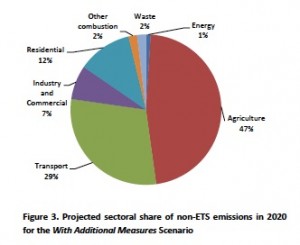Context
The European Union effort to control greenhouse gas (GHG) emissions provides for an Emissions Trading System (ETS), a cap-and-trade program that regulates only certain GHGs and certain sectors of the economy. Included, for the period 2013 to 2020, are carbon dioxide (CO2) from power and heat generation as well as energy-intensive industries (e.g., oil refineries, steel works, cement factories), and, only recently, commercial aviation (only flights within Europe until 2016). In addition, nitrous oxide (N2O) from production of certain acids, and perfluorocarbons (PFCs) from aluminium production are included. The ETS covers about 11,000 installations and regulates about 45% of EU GHG emissions. By 2020, emissions from the ETS sectors are expected to be 21% lower than in 2005.
All those sectors of the economy not included within the ETS are subject to other legally binding targets for GHGs by 2020, and beyond, and the status of their emissions in Ireland is covered in a recent report from the Irish EPA, Greenhouse Gas Emission Projections to 2020: An Update (March 2016).
Each country was assigned a target for its non-ETS sectors under the EU Effort Sharing Decision. Under this Decision, Ireland is obligated to reduce GHG emissions by 20% in 2020 compared to 2005. Note 1.
The EPA Report: Key Trends
Between 2013 and 2015, Ireland was slightly below its maximum allowed GHG emission level, but only slightly. Under the rules applicable to non-ETS targets, a Member State can carry forward as a credit any savings in emissions in earlier periods. But as Ireland was only slightly below its requirements, any credit being carried forward is not sufficient to effect the outcome. For the period between 2016 and 2020, the Irish EPA has indicated that Ireland will miss its target.
In fact, by 2020 Ireland will manage to reduce GHG emissions not by 20% but only by 6% (with current measures) or 11% (with additional measures). At best that is a 50% shortfall in its obligations; at worst, it’s about a 66% shortfall.
The analysis by EPA covers both a scenario where only current mitigation measures are in effect, and another where additional mitigation measures are adopted by the government. The additional measures are referenced to the National Renewable Energy Action Plan and the National Energy Efficiency Action Plan. The problem here is that you have to wade through over 600 pages of reports to get a glimpse of, or guess, which measures are current and which are additional. It seems clear that for EPA the Additional Measures, whatever they are, are not realistic: “The challenges associated with implementing planned policies and measures that are aimed at reducing emissions under the With Additional Measures scenario should not be underestimated.”
The EPA Report: Sectoral Analysis – Our Farms and Our Roads
After presenting the background for the report, and its general trends, EPA analyzes the contributions of the major sectors. Again, there are no surprises here. By 2020, agriculture will account for 47% of non-ETS GHG emissions (about 30% of total GHG emissions), while transport will account for 29% of non-ETS emissions. Thus, the two sectors will account for a total of 76% of non-ETS emissions.
For the agriculture sector, EPA relies, as usual, on Teagasc, the Agriculture and Food Development Authority, a national body, for the data and analyses for the projected herd increases and the projected increase in emissions. EPA does not provide information about the Additional measures for agriculture and perhaps the report is silent on the issue as there is little faith that they will amount to much. Of course we do not have to rely on faith as Teagasc assures us that that the Additional measures will not amount to much. For the most telling data in this report is that Teagasc projects a 7% increase in agriculture emissions with current measures, and a 6% increase with Additional Measures. What this data tells us is that the government, and Teagasc, understand that with all its efforts and propaganda about how carbon-efficient the sector will be, so as to minimize the impact from the significant growth produced through Food Wise 2025, the reality is that they expect only a 1% saving IF all the Additional measures are implemented. Full implementation is unlikely given the added expense of many of the changes.
So Food Wise 2025, f/k/a Food Harvest 2020, will be allowed to grow as it pleases and the government’s best efforts to minimize the GHG impacts will be a 1% saving over current efforts.
The transport sector is not much better positioned. Emissions are expected to grow by 16% between 2014 and 2020 with current measures, and by only 10% with Additional measures, a 6% saving if more is done. Here EPA does point to some of the Additional measures, such as 10% renewable fuel used in transport, 50,000 electric vehicles deployed, and more “efficient eco-driving practices.” How credible are these Additional measures? Well, for instance, the total number of electric cars owned in Ireland was about 500 by mid-2014, and it is projected that the number will grow to 50,000 in next 4 and half years. That’s not too credible. And how many readers of the EPA report have been trained in eco-driving practices, or have used them, or have ever heard of them. Of course eco-driving makes sense and needs to be encouraged. The problem is that governments love to rely on savings from eco-driving since no new technology is needed and it costs nothing to do. The only complication is the need to change the long-held driving habits of millions of adults.
There is better news from the Residential building sector, in part because of the very useful and important work from Sustainable Energy Authority of Ireland (SEAI). The GHG emissions from this sector will grow by only 1% under current measures, and there will be a 13% decrease in emissions under the Additional measures scenario. We are given some clue as to the Additional measures from SEAI, which include a residential retrofit scheme and amendments to building regulations.
Conditions get better in the Industry and Commercial sector where GHG emissions are projected to decrease by 3% with current measures and 19% with Additional measures. Again, the improvement in building regulations accounts for much of the added savings in GHG emissions. Finally the waste sector is best of all where a decrease of 46% under both scenarios is expected. These results assume certain volumes of municipal waste are sent to incinerators rather than being landfilled.
In short, there will be some improvement in certain non-ETS sectors (residential, industry and waste), but savings in these sectors will not offset what is happening in agriculture and transport, and Ireland will not meet the overall 20% reduction.
The EPA report ends with a warning that as Ireland is not going to meet its 2020 targets from the EU, it will be obviously problematic for Ireland to meet the anticipated, more stringent targets to be set for 2030. In addition, the Irish government has adopted a policy, or vision, for 2050 where CO2 emissions for electricity, the built environment and transport will be reduced by 80%, compared to 1990 levels, and where agriculture and land-use will achieve “carbon neutrality,” never mind about methane. Given where we are now, that policy is more hallucinatory than visionary. Of course we want an 80% reduction, but we need the government to take it seriously. We do; it does not.
Conclusion: The Message and Messenger
During the important, even historic climate talks in Paris in December 2015, while most were working hard to push for greater transparency and tougher, clearer GHG targets, the Irish government was giving out to the Irish press that, in effect, climate change was no big deal, compared to the economic problems facing Ireland: “Climate change is not our priority.” Apparently the government, unlike most people, is not capable of multi-tasking.
The government’s position is in large part public posturing at a time when it is forcefully pursuing the interests of the agri-food industry (not the small Irish farmers) in negotiating with the EU to carve out some sort of exception for (grass-based) Irish agriculture in the setting of GHG emission targets and/or credits for carbon sinks in Ireland.
As the EPA report demonstrates, the government knows that Ireland cannot meet even modest GHG emission targets under current conditions in the agri-food sector, and that failure will deepen as the Food Wise 2025 policy is fully implemented, even with Additional measures. One suspects that what we’re seeing is an elaborate play where the government protests the EU obligations while it proceeds full steam ahead with Food Wise 2025, arguing that only Ireland can produce food without high carbon emissions because the dairy herds are feed by grass, ignoring as usual the methane emissions. If, and more likely when, the EU does not carve out the exception the government and industry want, then this alliance will shrugs its collective shoulders and say, with a wink and a nod, “Well we tried with that unreasonable EU, and it’s too late to pull back from Food Wise 2025, so someone else will have to sacrifice in order for Ireland to meets its GHG obligations.”
That someone else could be drivers of all vehicles, since transport is also out of control, or all citizens who will have to pay for the significant EU fines or for purchasing carbon-offset credits.
That’s the meta-message in this stage play. What about the messenger we have before us, the Irish EPA.
An editorial from The Irish Times struck a right chord in addressing this report. It notes that EPA is an independent body and it is supposed to raise public awareness and advise on policy, but that some “accuse” EPA of “being a watchdog that hardly ever barks.”
As the Irish Times editorial rightly picks up, EPA’s usual reticence makes this report all the more troubling since here EPA is fairly direct, if not assertive, in laying out the clear failures of the government to address its obligations under the EU.
As we have noted on previous occasions, EPA is very good at collecting and analyzing data and the science applicable to environmental matters. Its STRIVE research program has made major contributions to our understanding of climate change and other issues, as well as to the development of a body of expertise on climate change and other issues. EPA also offers many ways of communicating its findings through its website and conferences, and through Eco-Eye, a much watched and widely respected TV program, hosted by Duncan Stewart and funded, in part, by EPA. EPA has also developed a cadre of highly trained, dedicated staff.
But on the issue of agriculture and environmental matters, especially Harvest 2020 and Food Wise 2025, EPA seems reticent to criticise the government, the industry or Teagasc. To do so would be politically risky and while EPA is charactised as an independent entity, independence goes only so far.
The tension on how far to push on the serious problems that the government is creating can be seen in how careful EPA treads on the issue. In the report itself, in keeping with government practice, and artifice, the refrain is about getting agriculture to “carbon neutrality”.
In the press release on the report, EPA reiterates this position when it characterises the national policy as including a commitment to “achieving carbon neutrality in the agriculture and land use sectors.”
In addition in the press release, EPA argues that we must decarbonise energy, transport, and heating, and we must break our dependence on fossil fuel infrastructures. But for agriculture, forest and land use sectors, we only should make improvements, a less imperative obligation.
But also in the press release, EPA bluntly “cast doubts over efforts to transition to a low carbon economy in the long term.” Of course, we’re talking about doubting the government’s efforts. And at least here EPA switches to describing the goal for agriculture as achieving “greenhouse gas emissions neutrality” by 2050. Of course the term GHG emissions includes not just carbon but also methane, the intractable foe of agriculture, and the rest of Ireland.
Note 1. At the same time as the targets for reducing GHG emissions by 20% were set, in 2007-09, the EU committed to raising the share of renewables in energy consumption by 20%, and to a 20% improvement in energy efficiency, the so-called 20-20-20 targets for 2020. This EPA report addresses only the obligation covering GHGs.
Sources
Irish Environmental Protection Agency, Greenhouse Gas Emission Projections to 2020: An Update (March 2016). www.epa.ie/pubs/reports/air/airemissions/2020_GHG_Projections_2016_Bulletin.pdf
European Commission, The European Emissions Trading System (EU ETS). ec.europa.eu/clima/policies/ets/index_en.htm
“Inaction and lack of vision on climate change exposed,” The Irish Times (9 March 2016). www.irishtimes.com/opinion/inaction-and-lack-of-vision-on-climate-change-exposed-1.2566503
Irish Department of Communications, Energy & Natural Resources, Ireland’s National Renewable Energy Action Plan (NREAP). www.dcenr.gov.ie/energy/en-ie/Renewable-Energy/Pages/Action-Plan.aspx
Irish Department of Communications, Energy & Natural Resources, National Energy Efficiency Action Plan (NEEAP). www.dcenr.gov.ie/energy/en-ie/Energy-Efficiency/Pages/National-Energy-Efficiency-Action-Plan-(NEEAP).aspx
Coln Cleary, “Electric Cars In Ireland: How To Get To The Tipping Point?” Green Car Reports (7 Sept 2014). www.greencarreports.com/news/1094211_electric-cars-in-ireland-how-to-get-to-the-tipping-point
“Ecodriving: More than a drop in the ocean?” OECD Observer www.oecdobserver.org/news/fullstory.php/aid/2596/Ecodriving:_More_than_a_drop_in_the_ocean_.html
Department of the Environment, Community and Local Government, Climate Action and Low-Carbon Development National Policy Position Ireland. www.environ.ie/sites/default/files/migrated-files/en/Publications/Environment/Atmosphere/FileDownLoad%2C37827%2Cen.pdf
Paul Melia, “Climate change is not our priority – Taoiseach,” Irish Independent (1 Dec 2015). www.independent.ie/world-news/climate-change-is-not-our-priority-taoiseach-34248017.html





No comments yet, add your own below